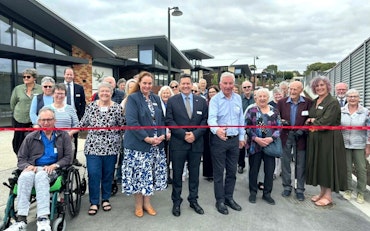New report finds funding increase and sustainability plan needed for aged care
A newly released discussion paper from the University of Technology Sydney (UTS) has highlighted the need to increase Government spending in the aged care sector along with the implementation of a sustainable strategic plan.
- Finance ,
- Government ,
- Leadership ,
- Providers
![<p>The research report looked at taxpayer affordability, community satisfaction with care, workforce availability and provider viability. [Source: Shutterstock]</p>](https://agedcareguide-assets.imgix.net/news/articles/news/articles/21_6_2022-Aged-care-plan.jpg?fm=pjpg&format=auto&w=550&q=65)
The research report looked at taxpayer affordability, community satisfaction with care, workforce availability and provider viability. [Source: Shutterstock]
The report, Sustainability of the Aged Care Sector: Discussion Paper, was released on Friday and aims to provide achievable and measurable options for those in the aged care sector, including for financial and provider viability.
Researchers of the UTS report state that “consequences of an unsustainable system are substantial” and “senior Australians will bear the brunt of a failing aged care sector”.
This report was commissioned by the Australian Aged Care Collaboration (AACC), industry peak body, with input from Council on the Ageing (COTA) Australia and National Seniors Australia.
While the report recommended a Government spending increase in aged care, it also touched on the fact that a sustainable aged care sector will only be possible if there is a multi-layered strategic response from the Government, sector stakeholders and consumers.
Spokesperson for the AACC and Interim Chief Executive Officer (CEO) of the Aged & Community Care Providers Association (ACCPA), Paul Sadler, says this paper has provided valuable insight into the changes necessary for the sector, including funding increases.
“Australia needs to urgently address long-term funding of aged care or it will be condemned to reliving the past of short-term fixes and band-aids,” says Mr Sadler.
“Funding fixes like the $18 billion in the 2021 Budget, while welcome, are not enough to address chronic workforce shortages and implement better standards that can be sustainable as costs increase and needs change.
“This means we need to start a national conversation involving consumers, aged care providers and other stakeholders in the sector, and Government, about how the aged care system can be sustainably funded, and whether that means individuals contribute more to their own care.”
The four main strategic approaches the discussion paper recommends for Government, sector stakeholders and consumers include:
- Measures to reduce the growth and demand for subsidised aged care services, this could be through investment in wellness, supporting informal carers, and facilitating opportunities to pay for non-subsidised top-up services
- Improving the aged care service effectiveness through different approaches, like changing policy settings and programs designed to produce better outcomes and reducing the overall growth of expenditure on services
- Improving service delivery efficiency using strategies such as workforce attraction, training and retention, promoting consumer choice, enhancing competition and removing barriers to aged care innovation
- Establishing equitable funding for subsidised services, such as requiring consumers with the capacity to pay fair contributions to put more towards the cost of services while ensuring services are affordable to all older Australians in need with appropriate safety nets
Mr Sadler says the industry’s wish to increase aged care spending was also backed by the Australian public.
The Royal Commission into Aged Care Quality and Safety commissioned research that found that 61 percent of Australian taxpayers were willing to pay more income tax to support better quality aged care.
This included paying an additional 1.4 percent per year on average to ensure satisfactory quality aged care and an additional 3.1 per year on average to provide older Australians in need with access to higher levels of quality aged care.
In the same commissioned research by Flinders University, Australia’s aged care system: assessing the views and preferences of the general public for quality of care and future funding, 64 percent of respondents were willing to pay a co-contribution to access satisfactory aged care and 46 percent were willing to pay a higher co-contribution to receive high quality residential care.
Chief Executive (CE) of COTA, Ian Yates, says that short-term, band-aid solutions to financing aged care have not worked in the past and won’t work in the future, which is why more thought needs to be put into finding sustainable ways to fund aged care.
“We need a shift to a financially sustainable system that together with other changes delivers the quality aged care to which older Australians and their families are entitled,” says Mr Yates.
“There’s no question that our aged care system is under stress and has been for a long time. Much of the system is underperforming. Adequate and consistent funding is necessary to underpin cultural and other essential changes.
“Unless we start having serious discussions about the long-term financial sustainability of aged care in this country we will not have an aged care system that delivers for older Australians.
“Older Australians have the right to an aged care system that allows and enables them to live their lives to the fullest and we need a sustainable system that makes that possible.”
CEO of National Seniors, Professor John McCallum, explains that while older people do think and plan for their retirement, they don’t often consider their future aged care needs until they have to – and usually that is when their needs are urgent.
“Since consumers will be important players in the decisions on funding, we will need to improve older Australians’ awareness of costs and funding options for the needs of later life. This report is a good place to start for this initiative,” says Professor McCallum.
The report also looked at taxpayer affordability, community satisfaction with care, workforce availability and provider viability.
To view the full Sustainability of the Aged Care Sector report, head to the UTS website.










